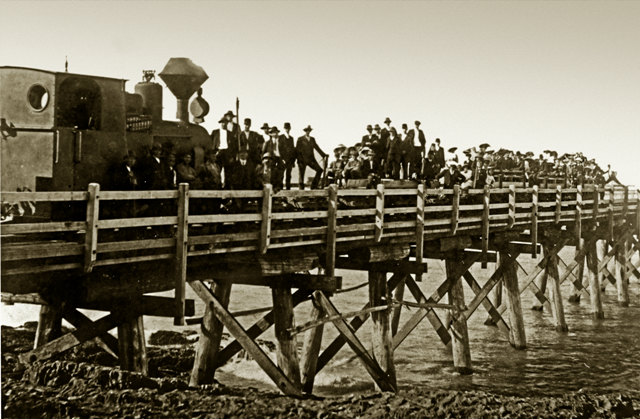From our Own Correspondent.
If there is one place more than another throughout the prosperous north-eastern portion of Tasmania that gives promise of looming into importance it is Bridport and the district surrounding it. The principal factor in this expected advancement are the operations of the Tasmanian Timber and Tramway Company-a progressive enterprise, encouraged by a Liberal Government which has the right to operate on valuable bolts of timber over an area of about 20,000 acres in the Forester district, within 15 miles of Bridport. As readers of “The Mercury” are aware, the company has erected a modern mill, furnished it with the latest and most up-to-date machinery, have constructed a tramline of 2ft gauge to Bridport, and are now sawing timber and carrying piles over their line to the site of the jetty at Bridport. This jetty is to be 1,000ft. Long. At present over 350ft of it is constructed, and the piles are driven for a distance of about 400ft. All this work is having an influence on the progress and expansion of the district, and, owing to the influx of workmen at the mill, and the growth of the Forester Settlement (many of the settlers earn good wages from the company), business on the whole is brisk, and it seems that a new era of prosperity has begun in the Bridport and Scottsdale districts. Years ago, before the Scottsdale railway was constructed, all the trade came via Bridport and goods for Scottsdale had to be hauled over 13 miles of rough road. Bridport at that time was fairly prosperous, but the advent of the railway nipped its growth in the bud, and the natural outlet for the North East Coast lay dormant until a couple of years ago. But it is not the timber company alone that will assist in its advancement. Many thousands of acres of land have been selected in the district, and areas that a few years back were only carrying two or three thousand sheep are now grazing something like 12,000, while miles of wire fencing are evidence of the activity of the holders. The Flinders Island cattle trade is bound to be catered for by our most progressive landholders, for as soon as the timber company’s jetty is completed, cattle can with ease be shipped to the island, and a nucleus of a trade established. The rest will follow. The distance across is only about 35 miles, and the settlers on the island are keenly desirous of connection with Bridport, as the means of providing better and quicker communication, and subsequently a better mail service. At present Mr. Oliver Adams is engaged carrying out the work of surveying Anderson’s Bay, and preparing working plans and specifications of the proposed harbour. As soon as this work is completed, steps should be taken to get the Government to construct the railway from Bridport to Lietinna as promised. It was recently suggested that the timber company might run a tram from Bridport to Scottsdale, and that their jetty could be used for the shipment of produce, etc. A number of residents favoured this course, but on the other hand, there is the feeling that such a step would not be satisfactory, giving only a haphazard service, limiting the sphere of its usefulness to the Scottsdale district- as beyond that town reloading would be necessary, owing to the different gauge-while it would seriously interfere with the progress of the larger movement, i.e., the construction of a pier and breakwater, and connecting it by rail with the Main Line-either at Lietinna or Scottsdale. A careful study of the whole question inspires the belief that the first cost of a standard line will be the cheapest in the end, and will have the additional advantage of being a benefit to the whole of the north-east portion of the island. Already we find cultivation has been started at Bridport. At one time this land was looked upon as barren and useless for any other than fire grazing purposes. Cultivation has lint grazing purposes. Mr. Ockerby has ploughed 11 acres as an experiment, and has sown with oats, which are looking remarkably well. The trouble in cultivating this land is solved by draining well, in order to prevent flooding in the winter time. Some areas have been soured through being covered by water for many years, but it is only a matter of efficient draining, until the land is easily sweetened. Mr. Heckrath has ploughed one of these once called barren flats, and it looks splendid. It is merely a question of time when this land will be realising high values. Messrs. Somerville and Dundee have cultivated flats which are proving annoying to their old critics. Messrs. Emmett Bros, who have had a wide experience in marsh land in New Zealand, are very highly impressed with their salt wood run. They have adopted a sound drainage system, and put in ring drains three foot deep around the flats. It is their intention to plough a large area for the cultivation of raised grasses, and there is no doubt that they will meet with sit success as the land has a good subsoil, and look well broken up. Last year they put a few lupin seeds on the around the ditches, and it was equal to anything grown on the best of chocolate land. The absence of timber makes these areas easy and cheap to work, the main cost being the drainage. In cultivating this land the holders have adopted the advice of the Director of Agriculture, and used lime for sweetening purposes. The Director too, holds the opinion that much of the land in the Bridport district is eminently suited for fruits growing. When we know that fruit grown in the district has gained first awards in competition with the much advertised Tamar Valley, the truth of the statement cannot be contested. Mr. Jas. Falbrook, near Lisle Road has an orchard three years old, and out of some samples exhibited at Lilydale took four firsts and one second and took first honours at East Tamar at the Albert Hall. The land where this orchard is laid out is white loam, quartz gravel, and yellow slate, well sheltered from the south and west winds, and facing the morning sun. We have thousands of acres of similar land in this district well sheltered, and it is easily cleared. It only requires a little capital and the right type of settler to turn this land into a valuable asset to the State, especially with a port right at their doors. The progress of the Tasmanian Timber and Tramway Company is watched with great interest. The company intend laying out a township and building workmen’s cottages, and have selected a site for the purpose facing the morning sun. By the time the company’s jetty is finished they will have expended something like £30,000. There can be no doubt as to the immense benefit such a large undertaking will be to this district and to the State in the near future. The building of the jetty at Bridport alone, and running a good line of tram into a fine belt of country, is a boon much greater than many people seem to realise. The mill is an up-to-date one in every respect. No expense has been spared to install labour-saving appliances, and when in full swing the daily output will be 20,000 feet. The timber is of splendid quality, and will take many years to cut out. The writer was informed that on one square acre section there is at a conservative estimate, a million feet of blackwood. *
*extract from- http://nla.gov.au/nla.news-article10287411 – 12/06/12
Edits by Bridport Innovations



